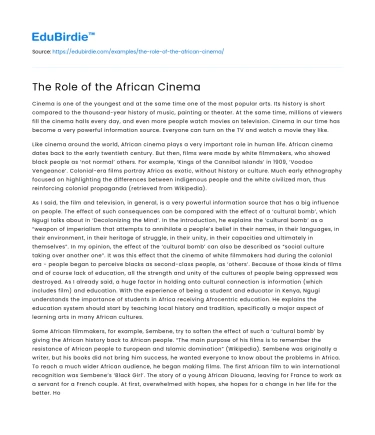Cinema is one of the youngest and at the same time one of the most popular arts. Its history is short compared to the thousand-year history of music, painting or theater. At the same time, millions of viewers fill the cinema halls every day, and even more people watch movies on television. Cinema in our time has become a very powerful information source. Everyone can turn on the TV and watch a movie they like.
Like cinema around the world, African cinema plays a very important role in human life. African cinema dates back to the early twentieth century. But then, films were made by white filmmakers, who showed black people as ‘not normal’ others. For example, ‘Kings of the Cannibal Islands’ in 1909, ‘Voodoo Vengeance’. Colonial-era films portray Africa as exotic, without history or culture. Much early ethnography focused on highlighting the differences between indigenous people and the white civilized man, thus reinforcing colonial propaganda (retrieved from Wikipedia).
Save your time!
We can take care of your essay
- Proper editing and formatting
- Free revision, title page, and bibliography
- Flexible prices and money-back guarantee
As I said, the film and television, in general, is a very powerful information source that has a big influence on people. The effect of such consequences can be compared with the effect of a ‘cultural bomb’, which Ngugi talks about in ‘Decolonizing the Mind’. In the introduction, he explains the ‘cultural bomb’ as a “weapon of imperialism that attempts to annihilate a people’s belief in their names, in their languages, in their environment, in their heritage of struggle, in their unity, in their capacities and ultimately in themselves”. In my opinion, the effect of the ‘cultural bomb’ can also be described as “social culture taking over another one”. It was this effect that the cinema of white filmmakers had during the colonial era - people began to perceive blacks as second-class people, as ‘others’. Because of those kinds of films and of course lack of education, all the strength and unity of the cultures of people being oppressed was destroyed. As I already said, a huge factor in holding onto cultural connection is information (which includes film) and education. With the experience of being a student and educator in Kenya, Ngugi understands the importance of students in Africa receiving Afrocentric education. He explains the education system should start by teaching local history and tradition, specifically a major aspect of learning arts in many African cultures.
Some African filmmakers, for example, Sembene, try to soften the effect of such a ‘cultural bomb’ by giving the African history back to African people. “The main purpose of his films is to remember the resistance of African people to European and Islamic domination” (Wikipedia). Sembene was originally a writer, but his books did not bring him success, he wanted everyone to know about the problems in Africa. To reach a much wider African audience, he began making films. The first African film to win international recognition was Sembene’s ‘Black Girl’. The story of a young African Diouana, leaving for France to work as a servant for a French couple. At first, overwhelmed with hopes, she hopes for a change in her life for the better. However, disappointment soon comes. ‘Black Girl’ became for Sembene not only a way to express all the pain caused by an unresolved racial issue, not only an opportunity to show the reverse side of reality, unusual for the European eye. It is so straightforward that it can hardly even be called a work of art. It is more reminiscent of the work of a journalist or, in extreme cases, a diploma of a student of a cinema university. Diouana’s life is shown in one black without semitones, although, by and large, Sembene does not show any horrors. Reading from different sources about ‘Black Girl’, I found a really interesting explanation of it in Wikipedia: “This film addresses the effects of colonialism, racism and post-colonial identity in Africa and Europe. These themes are highlighted through the recurring appearance of an African mask that Diouana gives to her employers on her first day of work at the house. They put the mask with other pieces of African Art and, later, the mask is hung on the white wall in the French couple's Senegalese apartment, alone. Also, the film, being from the perspective of a Senegalese female, acts as a rare reflection of the voices of the colonized”.
So, in conclusion, the tasks of African filmmakers can be compared to tasks of Griots. Like Griots, filmmakers want to convey the true culture of Africa in their films.






 Stuck on your essay?
Stuck on your essay?

